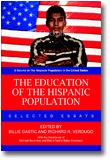
The Education of the Hispanic Population
Selected Essays
Edited by:
Billie Gastic, Beam Youth Collaborative
Richard R. Verdugo, UAB - Centre for Demographic Studies, Barcelona, Spain
A volume in the series: The Hispanic Population in the United States. Editor(s): Richard R. Verdugo, UAB - Centre for Demographic Studies, Barcelona, Spain.
Published 2012
This volume brings together the latest research and scholarship on Latinos in the United States. This book is special in terms of the broad scope of topics covered and methodologies employed in pursuit of knowledge about Latino students. This collection is also unique in that it features the work of more than a dozen Latino scholars—both early-careerand established—applying their research expertise to investigate and elucidate the educational experiences of Latinos in the United States.
The themes that are discussed in the chapters of The Education of the Hispanic Population: Selected Essays, reflect the wide-ranging discussions that are occurring in schools and school districts across the country and issues that are being carefully investigated by researchers who are committed to contributing thoughtful and meaningful scholarship of consequence for improving conditions for Latino youth.
CONTENTS
Foreword: Education and the Future of Latinos in the United States, Pedro A. Noguera. Preface, Billie Gastic and Richard R. Verdugo. Latina/o High School Students’ Academic Track Placement and Their Mathematics Achievement, Eduardo Mosqueda. The Latino Paradox? School Segregation and Latino Student Achievement, Stephanie Potochnick and Sudhanshu Handa. Beyond School Structures and Individual Blame: Centralizing School Culture to Understand and Respond to the Latina/o Dropout Crisis, Louie F. Rodriguez. Hispanics, Hispanic Immigrants, and the Hispanic Dropout Rate, Richard R. Verdugo.Marguerite Lukes. Navigating Middle School Transitions: The Role of Track Placement, Peer Networks, and Teacher Support in Shaping a Sense of Belonging to School, Eréndira Rueda. Immigrant Student Educational Experiences in an Emerging Latina/o Community in the Midwest, Melissa Quintela. “Do I Look Illegal?” Undocumented Latino Students and the Challenges of Life in the Shadows, Mariela Nuñez-Janes and Shaun Chapa. Mexican-American Schoolchildren in U.S. Public Schools: A Review of Social Science Research on the Mexican-American Family’s Cultural Capital, Adalberto Aguirre, Jr., Ruben Martinez, Sandra Barboza. The Educational Benefits of Mentoring for Latino Youth: Insights From a National Study, Billie Gastic, Diana Salas Coronado, David González Nieto. Urban Latino Parents’ Narratives of Parent Involvement, Mary Christianakis and Richard Mora. Latino Parent Involvement and the School System: Deconstructing Isolation and Inequality, Edward M. Olivos and Marcela Mendoza. Meeting the Needs of Hispanic Students in Public Schools: Implications for Principal Preparation, Mariela A. Rodríguez, María Luisa González, and Encarnacion Garza, Jr. The Role of Dual Credit/Dual Enrollment Courses in the Recruitment and Retention of Hispanic Students in Higher Education, Belinda Roman. Does the “Mismatch Hypothesis” Apply to Hispanic Students at Selective Colleges? Joanne W. Golann, Kerstin Gentsch, Chang Y. Chung, and Thomas J. Espenshade. Leaving Latino Males Behind, Theresa Montaño and John Perez. From a Man’s Perspective: Latino Men’s Outlook on the Campus Community, Darnell Cole and Araceli Ayala Espinoza. Un Camino Solitario!/A Lonely Road!: Chicana/o Faculty Storytelling and Counterstorytelling in Academia, Juan Carlos González, Gloria Vaquera, Cynthia Bejarano and Edwardo L. Portillos. About the Authors.
-
Paperback978-1-61735-956-9
Web price: $45.04 (Reg. 52.99)
-
Hardcover978-1-61735-957-6
Web price: $80.74 (Reg. 94.99)
- eBook978-1-61735-958-3

- EDU020000 - EDUCATION: Multicultural Education
- EDU005000 - EDUCATION: Bilingual Education
- EDU038000 - EDUCATION: Student Life & Student Affairs
-
 Affirming Identity, Advancing Belonging, and Amplifying Voice in Sororities and Fraternities
Affirming Identity, Advancing Belonging, and Amplifying Voice in Sororities and Fraternities
-
 Hispanics in the US Labor Market
Selected Research
Hispanics in the US Labor Market
Selected Research
-
 Special Education During the Pandemic
Considerations for Change in Practice
Special Education During the Pandemic
Considerations for Change in Practice
-
 The Demography of the Hispanic Population
Selected Essays
The Demography of the Hispanic Population
Selected Essays
-
 The Economic Status of the Hispanic Population
Selected Essays
The Economic Status of the Hispanic Population
Selected Essays
-
 The Spanish Language in America
A Case of Social Stratification
The Spanish Language in America
A Case of Social Stratification
-
 The Yellow Rose
Racial Stratification in a Mexican American Community
The Yellow Rose
Racial Stratification in a Mexican American Community

